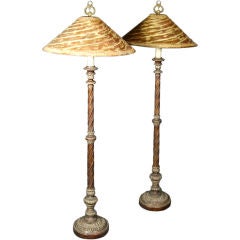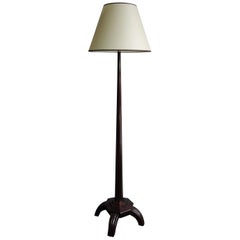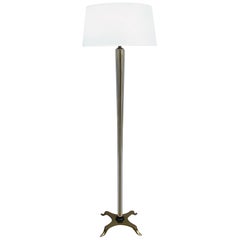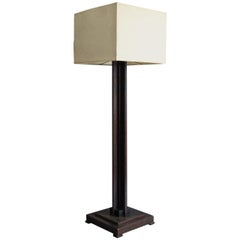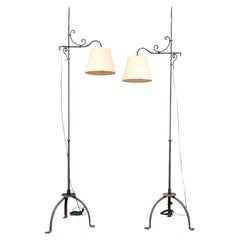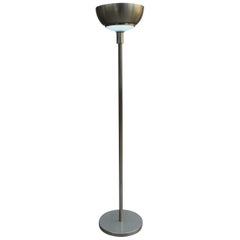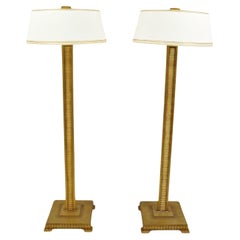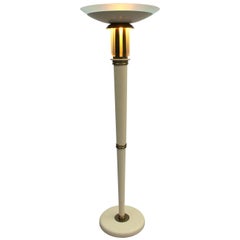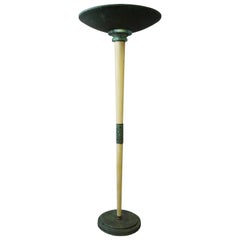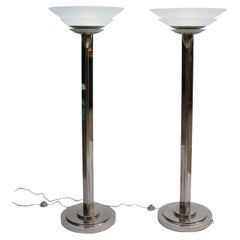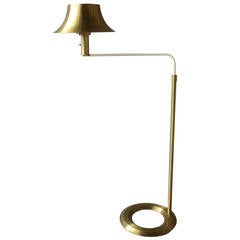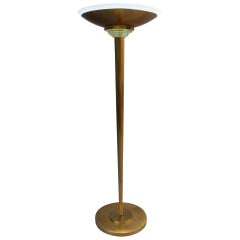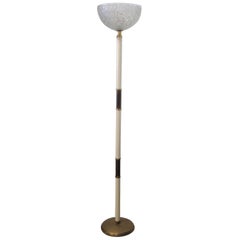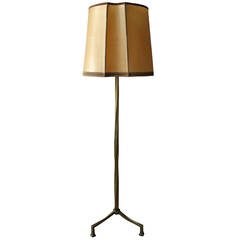Fine Art Floor Lamp
20th Century American Floor Lamps
Iron, Gold, Silver Leaf, Gold Leaf
Vintage 1920s French Art Deco Floor Lamps
Fabric, Rosewood, Paper
Vintage 1940s French Art Deco Floor Lamps
Bronze
Vintage 1930s French Art Deco Floor Lamps
Antique 19th Century Folk Art Floor Lamps
Iron
Vintage 1940s French Art Deco Floor Lamps
Nickel
21st Century and Contemporary Modern Floor Lamps
Metal
Vintage 1930s French Art Deco Floor Lamps
Brass
Vintage 1930s French Art Deco Floor Lamps
Metal
Vintage 1940s French Art Deco Floor Lamps
Nickel
Vintage 1930s French Art Deco Floor Lamps
Brass
Vintage 1940s French Art Deco Floor Lamps
Bronze
Vintage 1930s French Art Deco Floor Lamps
Metal
Vintage 1950s French Mid-Century Modern Floor Lamps
Chrome
Vintage 1930s French Mid-Century Modern Floor Lamps
Brass
Vintage 1930s French Art Deco Floor Lamps
Wrought Iron
Antique Early 1900s American Art Nouveau Floor Lamps
Bronze
Vintage 1930s French Art Deco Floor Lamps
Brass
Antique Early 1900s American Art Nouveau Floor Lamps
Bronze
Recent Sales
Vintage 1950s Italian Mid-Century Modern Floor Lamps
Brass
Vintage 1940s French Art Deco Floor Lamps
20th Century Spanish Colonial Floor Lamps
Wrought Iron, Gold Leaf
Late 20th Century Other Floor Lamps
Metal
Vintage 1930s French Art Deco Floor Lamps
Bronze
Vintage 1930s French Art Deco Floor Lamps
Glass
Mid-20th Century English Art Deco Floor Lamps
Beech
Mid-20th Century Japanese Furniture
Metal
Antique Mid-19th Century Japanese Meiji Furniture
Wood
Antique Mid-19th Century Japanese Meiji Sculptures and Carvings
Wood
21st Century and Contemporary Moroccan Sculptures and Carvings
Copper
21st Century and Contemporary Moroccan Sculptures and Carvings
Copper
Vintage 1940s French Art Deco Floor Lamps
Brass
Vintage 1930s French Art Deco Floor Lamps
Vintage 1930s French Art Deco Floor Lamps
Vintage 1940s French Art Deco Floor Lamps
Bronze
Late 20th Century American Art Nouveau Floor Lamps
Metal, Lead
Vintage 1910s Floor Lamps
Art Glass
Antique Late 19th Century Japanese Meiji Furniture
Wood
Antique Mid-19th Century Japanese Meiji Sculptures and Carvings
Wood
20th Century French Art Deco Floor Lamps
Brass
Early 20th Century American Art Deco Floor Lamps
20th Century American Art Deco Floor Lamps
Metal
Early 20th Century American Art Deco Floor Lamps
Brass
Vintage 1930s Floor Lamps
20th Century American Art Nouveau Floor Lamps
Bronze
20th Century American Floor Lamps
Iron
People Also Browsed
21st Century and Contemporary American Modern Side Tables
Iron
2010s American Mid-Century Modern Chandeliers and Pendants
Metal
21st Century and Contemporary French Art Deco Side Chairs
Wrought Iron
21st Century and Contemporary American Mid-Century Modern Benches
Walnut, Oak
Vintage 1970s French Mid-Century Modern Table Clocks and Desk Clocks
Silver Plate, Enamel
21st Century and Contemporary American Scandinavian Modern Wall Lights a...
Brass, Nickel
21st Century and Contemporary German Mid-Century Modern Chandeliers and ...
Metal, Iron
Antique 19th Century English Rustic Cupboards
Wood, Pine
Vintage 1980s Italian Wall Lights and Sconces
Metal, Enamel
Antique 1870s English Victorian Armchairs
Velvet
Early 20th Century French Art Deco Bedroom Sets
Vintage 1930s French Art Deco Floor Lamps
Wood
Antique 19th Century French Louis XV Armchairs
Velvet, Wood, Paint
2010s American Modern Table Lamps
Ceramic
2010s Spanish Country Patio and Garden Furniture
Wrought Iron
2010s Belgian Modern Sofas
Linen
Fine Art Floor Lamp For Sale on 1stDibs
How Much is a Fine Art Floor Lamp?
Finding the Right Floor-lamps for You
The modern floor lamp is an evolution of torchères — tall floor candelabras that originated in France as a revolutionary development in lighting homes toward the end of the 17th century. Owing to the advent of electricity and the introduction of new materials as a part of lighting design, floor lamps have taken on new forms and configurations over the years.
In the early 1920s, Art Deco lighting artisans worked with dark woods and modern metals, introducing unique designs that still inspire the look of modern floor lamps developed by contemporary firms such as Luxxu.
Popular mid-century floor lamps include everything from the enchanting fixtures by the Italian lighting artisans at Stilnovo to the distinctly functional Grasshopper floor lamp created by Scandinavian design pioneer Greta Magnusson-Grossman to the Paracarro floor lamp by the Venetian master glass workers at Mazzega. Among the more celebrated names in mid-century lighting design are Milanese innovators Achille and Pier Giacomo Castiglioni, who, along with their eldest brother, Livio, worked for their own firm as architects and designers. While Livio departed the practice in 1952, Achille and Pier Giacomo would go on to design the Arco floor lamp, the Toio floor lamp and more for legendary lighting brands such as FLOS.
Today’s upscale interiors frequently integrate the otherworldly custom lighting solutions created by a wealth of contemporary firms and designers such as Spain’s Masquespacio, whose Wink floor lamps integrate gold as well as fabric fringes.
Visual artists and industrial designers have a penchant for floor lamps, possibly because they’re so often a clever marriage of design and the functions of lighting. A good floor lamp can change the mood of any room while adding a touch of elegance to your entire space. Find yours now on 1stDibs.
Read More
These Designer Light Fixtures Are Total Scene Stealers
Across New York, there’s no shortage of statement lighting on view.
My Father Was Obsessed with This French Art Deco Tiger Lamp
The 1920s design is a thrilling combination of saturated colors, ancient motifs and modern aesthetics.
Hans Bergström’s Monumental Chandeliers Are Made for Grand Spaces
Designed by a giant of Swedish lighting, the large-scale fixtures bring major drama.
This Paavo Tynell Chandelier Is a Radiant Bouquet
The alluring pendant light exemplifies the designer’s winsome mid-career work.
Ettore Sottsass Captures a Shooting Star in This Rare 1970s Floor Lamp
Before founding the Memphis Group, Sottsass bent the rules of lighting design with the wonderfully wavy Cometa.
You Don’t Need a Fictional Fairy to Get This Real Pinocchio Lamp
Warm chalet style meets cool Bauhaus functionality in Pietro Cascella’s cleverly carved creation.
Why Is Italy Such a Hotbed of Cool Design?
Patrizio Chiarparini of Brooklyn’s Duplex gallery sheds light on the lasting legacy of Italy’s postwar furniture boom.
With a High-Tech Flagship and Cool Collabs, Lladró Is Breaking the Mold for Porcelain Production
Thanks to its new leadership, the Spanish maker of figurines, busts and lighting is on a mission to update the art of porcelain for the 21st century.
